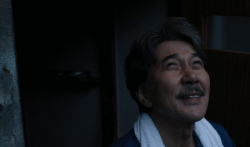“The great thing about couples is they arrange themselves in these weird positions,” Amy Sillman explains in an exhibition publication about her series of paintings, Third Person Singular. At Sillman’s new show at the Hirshhorn Museum, you can see that she’s on to something: the entrance wall is covered with black-and-white sketches of various pairs lazily sprawled over each other on a couch, rigidly sitting straight up with arms awkwardly around each other’s backs, or curving their legs to play footsie at a dinner party. The heart of Sillman’s work, though, is the abstracted bursts of garish color that develop from these primary studies of geometric relationships between bodies.
Located in a small gallery on the museum’s circular top floor, Third Person Singular is part of the Hirshhorn’s “Directions” series, which features up-and-coming artists. Normally exhibits like this are more likely to be found in Brooklyn—where Sillman lives—or the Dupont Circle galleries, but Singular is a nice addition to the more mainstream National Mall.
Sillman asked 17 couples she knew if she could sketch them, and got enthusiastic reactions. “I’ve drawn people who immediately got into some romantic pretzel shape,” she explains, “or people who said, ‘Can we take off our clothes?’” For this study, though, Sillman was more interested in the spaces and shadows between bodies than anatomical details. She has a refreshing sense of humor about her work, both when discussing it and when painting it: in one portrait titled “R & J” (named after the couple’s initials, like the others in the series), a squiggly-rendered poodle takes up half the space of the page, leaving the couple squished to the other side, perhaps slyly poking fun at obsessive dog parents.
The fairly recognizable couple studies morph into abstracted depictions of space, depth and structure in Sillman’s large oil paintings. It seems like the Hirshhorn is trying to explain the origin of highly abstracted pieces by including Sillman’s early sketches along with the endlessly reworked final products, but it might have been more helpful to include some midpoint works to more effectively elucidate the process of abstraction.
Nevertheless, the later works clearly relate to the couple studies. Sillman paints with high contrasts, strong outlines and a fascinating sense of depth in both the ink and oil pieces. “P & H 2 (behemoth)” has scaffolding, windows and dark rectangular shapes that create the vertiginous sensation of looking down at a refracted urban landscape. Other works have a hint of a horizon line that adds to the spatial sense, despite a jarring orange and seafoam green color combination.
Sillman’s complex forms might not be recognizable, but they’re still intricate and engaging—especially compared to permanent Hirshhorn pieces like Josef Albers’ equally gaudily colored Homage to the Square series, which sets flat squares of different hues within each other in that quintessentially “I-could-have-done-that” postwar-abstract-expressionist fashion. Maybe she sees landscapes in the nooks and crannies between couples’ limbs, or maybe the shapes come from some abstract construct–or maybe not. In any case, the works in Third Person Singular create tangible objects that invite endless interpretation.
Third Person Singular is on display at the Hirshhorn until July 6. Admission is free.




